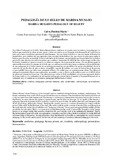| dc.rights.license | http://creativecommons.org/licenses/by-nc-sa/3.0/ve/ | |
| dc.contributor.author | Calvo, Patricia María | |
| dc.date.accessioned | 2016-09-28T13:55:19Z | |
| dc.date.available | 2016-09-28T13:55:19Z | |
| dc.date.issued | 2016 | |
| dc.identifier.issn | 1690-3226 | |
| dc.identifier.uri | http://www.saber.ula.ve/handle/123456789/42391 | |
| dc.description.abstract | En el libro Pedagogía de lo bello, Marisa Musaio busca establecer un puente entre la estética y la pedagogía. La
belleza que emana de las obras de arte puede y debe convertirse en un elemento de la formación de la persona en
tanto que el arte es también expresión del alma humana. De esta forma la belleza es una rica fuente de formación
humanística, pero también hay que aprender cómo trasmitir dicha belleza: hay que educar la retina para captar la
belleza, para descifrar su mensaje. Como el arte habla de lo humano, una pedagogía que busque beber de la estética
precisa de estar abierta a las otras disciplinas que estudian e interpretan las obras de arte: la psicología, la filosofía,
la historia. Estudiar el proceso creativo, es entrar en contacto con la persona del artista. En una primera parte la
autora reflexiona sobre el concepto de lo bello que va a utilizar en toda la obra, luego se detiene en las posibilidades
de una pedagogía de lo bello a partir de un enfoque personalista que posibilite una mejor educabilidad. Se da la conexión de que la obra de arte es única, irrepetible, cargada de sentido, así como la formación de la persona es una realidad única que debe estar orientada al bien y la verdad para ser auténticamente plena. Por último el
enfoque hermenéutico busca una xplicación, un sentido, y esto es básico en la estética como en el difícil oficio
de autoconocimiento de la persona. Una educación que valore lo bello posibilitará a la persona que pueda abrirse de forma creativa a la contemplación del mundo (pedagogía externa hacia el mundo) y la propia búsqueda de su verdadero ser y el sentido de su existencia (pedagogía interna hacia el alma). | es_VE |
| dc.language.iso | es | es_VE |
| dc.rights | info:eu-repo/semantics/openAccess | |
| dc.subject | Estética | es_VE |
| dc.subject | Pedagogía | es_VE |
| dc.subject | Persona humana | es_VE |
| dc.subject | Arte | es_VE |
| dc.subject | Creatividad | es_VE |
| dc.subject | Antropología | es_VE |
| dc.subject | Personalismo | es_VE |
| dc.subject | Hermenéutica | es_VE |
| dc.title | Pedagogía de lo Bello de Marisa Musaio | es_VE |
| dc.title.alternative | Marisa Musaio`s Pedagogy of Beauty | es_VE |
| dc.type | info:eu-repo/semantics/article | |
| dc.description.abstract1 | Marisa Musaio’s book Pedagogy of the beautiful seeks to establish a bridge between aesthetics and pedagogy. The
beauty emanating from works of art can and should become an element of the formation of the human person as art is also an expression of the human soul. Thus beauty is a rich source of humanistic education, but in order to convey
that beauty we must educate the retina to capture beauty and decipher its message. As art speaks of the human, a pedagogy that seeks to inspire itself in aesthetics, needs to be open to other disciplines that study and interpret works
of art: psychology, philosophy, history. Studying the creative process is a means of entering in contact with the person of the artist. In the first part of her study, the author reflects on the concept of beauty to be used throughout
the work; then she studies the possibilities of a “pedagogy of beauty” from a personal approach that enables a better possibility for education. There is a connection existing between the work of art and the formation of the human
person as an unique reality that must be oriented to the good and the truth to be authentically plentiful. Finally
the hermeneutical approach seeks an explanation, a meaning, and this is basic both in aesthetics as in the difficult
self-knowledge of the person. An education that values the beautiful will enable to contemplate the world (external
pedagogy to the world) and to search for the true self and meaning of existence (internal pedagogy to the soul). | es_VE |
| dc.description.colacion | 240-244 | es_VE |
| dc.description.email | pato.calvo@gmail.com | es_VE |
| dc.description.frecuencia | Semestral | |
| dc.identifier.eissn | 2244 - 842X | |
| dc.identifier.eissn | 2244 - 842X | |
| dc.subject.facultad | Núcleo Rafael Rangel (NURR) | es_VE |
| dc.subject.institucion | Universidad de Los Andes | es_VE |
| dc.subject.keywords | Aesthetics | es_VE |
| dc.subject.keywords | Pedagogy | es_VE |
| dc.subject.keywords | Human person | es_VE |
| dc.subject.keywords | Art | es_VE |
| dc.subject.keywords | Creativity | es_VE |
| dc.subject.keywords | Anthropology | es_VE |
| dc.subject.keywords | Personalism | es_VE |
| dc.subject.keywords | Hermeneutics | es_VE |
| dc.subject.pais | Venezuela | |
| dc.subject.publicacionelectronica | Academia | |
| dc.subject.thematiccategory | Artes y Humanidades | es_VE |
| dc.subject.tipo | Revistas | es_VE |
| dc.type.media | Texto | es_VE |


